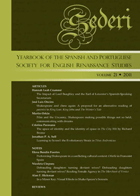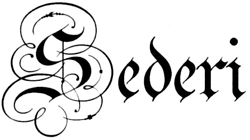
Sederi 21
Sederi 21 — 2011
EDITORS
Berta Cano Echevarría & Ana Sáez-Hidalgo
REVIEW EDITOR
Francisco J. Borge López
ISSN 1135-7789
Alan F. Hickman, “In a Minor Key: Visual Effects in Shake-Speare’s Sonnets.” SEDERI 21 (2011): 147-161.
DOI: https://doi.org/10.34136/sederi.2011.8 Download PDF
Abstract
Students of the sonnets are no doubt aware that they abound in wordplay that rewards multiple readings. They may be less aware, especially if they are unfamiliar with the original 1609 Quarto edition, that the poems may have been arranged to have a visual impact as well. The sonnet form itself is emblematic of a number of familiar referents, including an escutcheon, a “glass” (mirror), a leaf, and a seal. One might even see in the poems, as did Lady Mary Worth and John Donne in their “crowns” of sonnets, the links in a chain, or necklace. The sonnet form is roughly the poetic equivalent to the portrait miniature (a fad of the day) in art. I shall be pursuing these analogies in my paper. The most striking visual effect occurs in Sonnet 126, the last of the “fair youth” sonnets, which consists of six rhymed couplets followed by two empty sets of brackets. Katherine Duncan-Jones and others have, in recent years, argued authorial intent for this alleged “printer’s error.” Duncan-Jones suggests that the open parentheses may signify the poet and the fair youth’s “failure to couple,” while John Lennard sees in them “the silence of the grave.” I hope to demonstrate that, by thinking in visual terms, we might one day be able to unlock the story behind the most enigmatic verse sequence in English poetry.
Keywords: Renaissance; England; Shakespeare; sonnet; typography; book design.
References
Atkins, Carl D. 2004. “The Application of Bibliographical Principles to the Editing of Punctuation in Shakespeare’s Sonnets.” Studies in Philology 100/4: 493-513. <url: http://www.jstor.org >. Last accessed 18/05/2010.
Booth, Stephen 1977. Shakespeare’s Sonnets. New Haven: Yale University Press.
Coombs, Katherine 1998. The Portrait Miniature in England. London: V&A.
Crystal, Ben 2009. Shakespeare on Toast. London: Icon Books.
Davies, Nigel 2010. “The Sequencing of Shakespeare’s Sonnets.” The Place 2 B <url: http://www.geocities.com/Athens/Troy/4081/Sonnets.html >. Last accessed 19/05/2010.
Duncan-Jones, Katherine ed. 2007. Shakespeare’s Sonnets. London: Arden.
Eagle, R. L. 1947. “The Headpiece on Shakespeare’s Sonnets, 1609.” Notes and Queries 192/2: 38.
Fumerton, Patricia 1986. “‘Secret’ Arts: Elizabethan Miniatures and Sonnets.” Representations 15: 57-97.
Greenblatt, Stephen 2004. Will in the World: How Shakespeare Became Shakespeare. London: W. W. Norton & Company.
Gurr, Andrew, and Mariko Ichikawa 2000. Staging in Shakespeare’s Theatres. Oxford: Oxford University Press.
Harvey, Elizabeth D. 2007. “Flesh Colors and Shakespeare’s Sonnets.” Ed. Michael Carl Schoenfeldt. A Companion to Shakespeare’s Sonnets. Malden, MA: Blackwell. 314-328.
Heylin, Clinton 2009. So Long as Men Can Breathe: The Untold Story of Shakespeare’s Sonnets. Philadelphia: Da Capo Press.
Kalas, Rayna. “Fickle Glass.” Ed. Michael Carl Schoenfeldt. A Companion to Shakespeare’s Sonnets. Malden, MA: Blackwell. 261-276.
Ledger, G. R. 2009. The Amazing Web Site of Shakespeare’s Sonnets. <url: http://www.shakespeares-sonnets.com>. Last accessed 20/05/2010.
Marshall, Brooke 2008. “Typography and Renaissance-Era Eroticism.” WPDFD. <url: http://www.wpdfd.com/issues/87/typography-renaissance-era-eroticism >. Last accessed 17/07/2008.
North, Mary. “The Sonnets and Book History.” Ed. Michael Carl Schoenfeldt. A Companion to Shakespeare’s Sonnets. Malden, MA: Blackwell. 204-221.
Palfrey, Simon, and Tiffany Stern 2007. Shakespeare in Parts. Oxford: Oxford University Press.
Patterson, Don 2010. Reading Shakespeare’s Sonnets: A New Commentary by Don Patterson. London, Faber.
Rollins, Hyder Edward ed. 1944. A New Variorum Edition of Shakespeare: The Sonnets. Vol.25 (Part II). Philadelphia: Lippincott.
Schoenfeldt, Michael Carl ed. 2007. A Companion to Shakespeare’s Sonnets. Malden, MA: Blackwell.
Shapiro, James 2010. Contested Will: Who Wrote Shakespeare? London: Faber and Faber.
Siemens, R. G. 1998. Shakespeare’s Sonnets: A Facsimile of the Chalmers-Bridgewater Copy (Aspley Imprint) of the 1609 Quarto, in the Huntington Library. <url: http://extra.shu.ac.uk/emls/Sonnets/Sonnets.html>. Last accessed 19/05/2010.
Smith, Bruce R. 2009. The Key of Green: Passion and Perception in Renaissance Culture. Chicago: University of Chicago Press.
Vendler, Helen 1997. The Art of Shakespeare’s Sonnets. Cambridge: Harvard University Press.
West, David 2007. Shakespeare’s Sonnets. London: Duckworth Overlook.
Ziegler, Georgianna 2010. Folger Library. Email correspondence. March-April.
